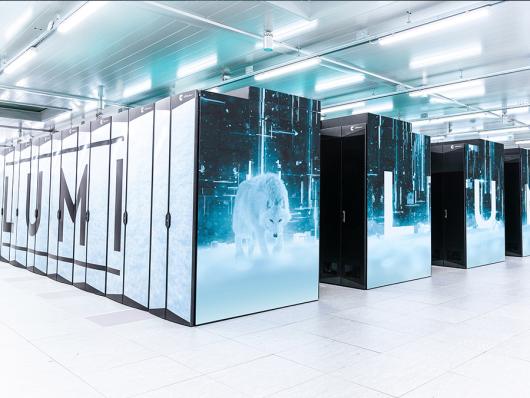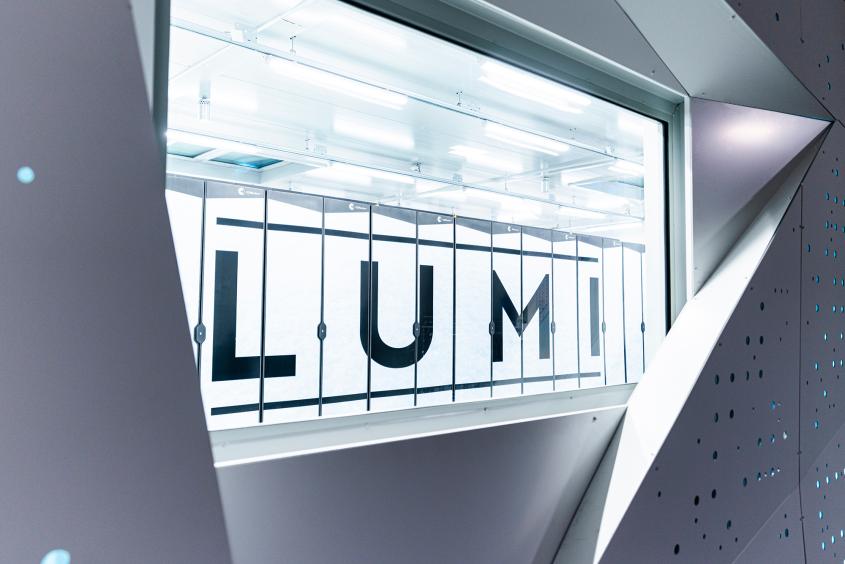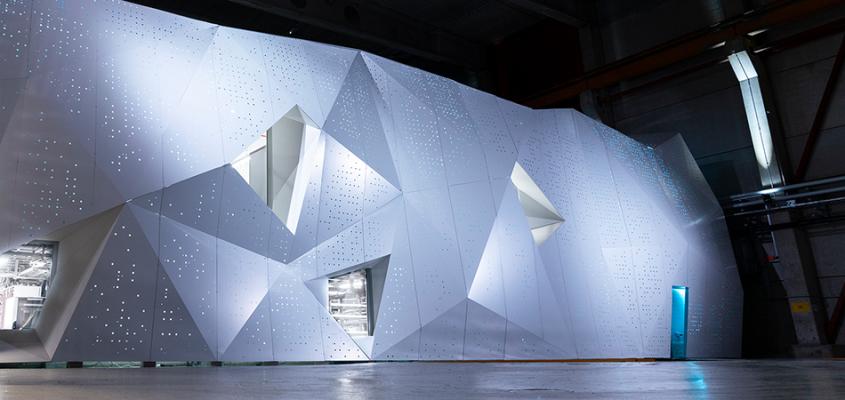LUMI is the EuroHPC Joint Undertaking's first pre-exascale supercomputer and currently stands as Europe’s most powerful supercomputer. The inauguration is scheduled for Monday, June 13, 2022, in Kajaani, Finland.
LUMI offers European researchers a world-class tool for understanding complicated phenomena, such as climate change. LUMI serves as a platform for international research cooperation and artificial intelligence and quantum technology development.

Part of the resources of the computer will focus on industrial research and development activities. LUMI's environmentally friendly solutions distinguish it from supercomputers known for their heavy use of energy. LUMI is a key tool in promoting digital and green transition throughout society.
LUMI is owned by the EuroHPC Joint Undertaking, and it is run by a consortium of 10 countries with long traditions and knowledge of scientific computing. Researchers all over Europe can apply for access to LUMI's resources, which means that all of Europe can benefit from this new research instrument. LUMI has been set up in Kajaani, in one of the world's greenest data centres, hosted by CSC – IT Center for Science Ltd.
– Today marks a major step for Europe’s digital and green transformation. LUMI is now the fastest and most energy-efficient supercomputer in Europe and one of the most powerful ones in the world. Thanks to its massive computing capacity, LUMI will enable scientific breakthroughs in for instance medicine and climate research at a much faster pace. It could be in the development of vaccines, diagnosis of cancer, or mitigation of the effects of climate change. This is a great example of the enormous potential of artificial intelligence to improve our lives, Margrethe Vestager, Executive Vice-President of the European Commission.

– The societal challenges for which we use supercomputers exist on a global scale. The extent of these challenges, and the work required to tackle and transform them into innovation opportunities, requires much collaboration across many branches of academia and countless research teams. It therefore can only make sense that one of the biggest and most important research infrastructures should be based on extensive collaboration. In this, EuroHPC's LUMI consortium collaboration is a pioneering effort to strengthen European competitiveness and digital sovereignty while promoting global research collaboration, says Anders Dam Jensen, Executive Director of the EuroHPC Joint Undertaking.
– LUMI is an ecosystem for high-performance computing, artificial intelligence, and data-intensive research, which enables breakthroughs in several branches of academic research. In addition, a fifth of LUMI's capacity is targeted to companies that are getting the opportunity to use methods of next-generation high-performance computing and to give rise to new skills and innovation, says Managing Director Kimmo Koski, of CSC, which operates LUMI.
LUMI, Europe's most powerful supercomputer, is also a partner for quantum computers
LUMI is Europe's most powerful supercomputer. LUMI was ranked third on the latest Top500 list of the world's fastest supercomputers, which was released at the end of May. LUMI's massive computing capacity is primarily based on its many graphics processors or GPU processors. They are especially suitable for use with various methods involving artificial intelligence, especially for deep learning. The LUMI supercomputer gives European researchers access to a world-class tool to help gain an understanding of complex phenomena.
- In Norway, we also see a sharp increase in the need for computing resources for artificial intelligence and machine learning. Modern tools in artificial intelligence have built-in support for graphics processors that can provide up to 250 times the performance increase compared to a regular processor. For example, the national supercomputers Betzy and Saga have 16 and 32 GPUs, respectively, providing a thousand times more performance than a standard PC. As a part-owner of LUMI, Norway will have access to a machine with a performance of more than 550 Pflops, equivalent to 5 million ordinary PCs, says Gunnar Bøe, Managing Director of Sigma2.
Quantum computers need supercomputers alongside them to harness their capacity to the right targets as a part of the research process.
– Finland possesses a significant quantum technology knowledge hub – also on a European level. The combination of high-performance and quantum computers strengthens the attractiveness of the quantum ecosystem in Finland and Europe. Jointly they create new kinds of opportunities for scientific computing as well as for industrial research and innovations, states Mika Lintilä, Minister of Economic Affairs and Employment in Finland.
Quantum computers, therefore, do not replace traditional supercomputers. Instead, the technologies are linked inseparably, giving the possibility to develop hybrid solutions that utilize the best parts of classical supercomputing and quantum computing. LUMI has so far been linked successfully with two quantum computers: the Swedish Chalmers/Wallenberg Centre for Quantum Technology QAL 9000 – and Finland's first quantum computer, the Helmi operated by VTT.
— Through our collaboration in the LUMI consortium, we can also give researchers in Norway the opportunity to participate in leading development in quantum computers and their use, says Hans Eide, Special Adviser in Sigma2.
Three Norwegian projects are getting ready to pilot LUMI-G
In the Solar Atmospheric Modeling project, Mats Carlsson at the Rosseland Centre for Solar Physics at the University of Oslo (UiO) and his colleagues work with simulations of the sun's atmosphere (the outer layers from which sunlight comes) and compare these with observations from solar telescopes on the ground and from space to learn more about how the sun, and thus other stars, work.
The in-house developed applications Bitfrost and Dispatch have contributed to making the research group a world leader in modeling the solar atmosphere. The applications are very parallel, which means that they use many processor cores to perform calculations faster. The application developers are working on adapting the code to the GPU. This makes the applications particularly well-suited for piloting on LUMI-G.
Another project, Imaging of seismic data, with Project Leader Børge Arntsen at the Department of Geoscience and Petroleum
at the Norwegian University of Science and Technology (NTNU) in charge, aims to get detailed images of the earth's interior using seismic data recorded on land and in the sea. We still know little about the earth's deep inner physical processes, but progress has been made in recent years using seismic waves and tomographic techniques like methods used in medical imaging.
To increase the level of detail, a new modeling technique is used where the idea is to simulate seismic data using a comprehensive numerical model. The simulations are repeated for many sources, and the great need for calculation makes the project a good candidate for piloting at LUMI-G.
Nordic language processing laboratory, a project led by Stephan Oepen at the Department for Informatics at the University of Oslo (UiO). Natural Language Processing (NLP) is an interdisciplinary branch of computer science and linguistics that enables everyday technologies and services such as automated translation (e.g., Google Translate), human-computer interaction in spoken language (e.g., Apple's Siri), or content recommendations and contextual advertising (e.g., on online news sites). Automated services like this are only possible through machine learning and the "deep learning" of models.
Neural language models have led to breakthroughs in recent years, but training the models, refining and user training requires an enormous amount of computing power. Therefore, Oepen and his colleagues will be one of the Norwegian pilot projects at LUMI-G.
What are supercomputers needed for?
– Efficient scientific computation is needed for doing top research in academic fields with a strong focus on data and computing, in medicine and climate research for example. Computer simulations help in studying phenomena such as climate change and the melting of ice caps, solving questions related to renewable energy and fusion energy, developing new vaccines faster than before, and finding more effective treatments and medicines, says Pekka Manninen, the CSC Director responsible for the LUMI supercomputer.
Digitalisation means making all of society more data-intensive, which means that effective capacity for the analysis of large masses of data is needed in all fields and sectors of academic research. Digital humanities are a rising trend in high-performance computing in the 21st century. Social scientists and humanists have long used statistics, registered data, and electronic language materials; digitalisation has brought new ways of doing research.
– Computational methods have moved forward at a dizzying speed in our field, notes Associate Professor Sampo Pyysalo of the TurkuNLP research group that is developing language models at the University of Turku, Finland.
The overall societal impact of supercomputers is significant. Research, development, and innovation activities conducted with them advance well-being, health, employment, and economic growth in a sustainable manner and for the long term.
–Science changes the world. With increasing computing capacity we get answers to diverse challenges in numerous different fields of research. LUMI opens new opportunities for international research cooperation and strengthens Finland’s profile as a knowledge-intensive country, says Petri Honkonen, Minister of Science and Culture in Finland.
Bringing digitalisation and artificial intelligence methods to a new level
Artificial intelligence systems are based on demanding machine learning utilising masses of data that require effective computational capacity. LUMI is one of the most advanced platforms for artificial intelligence. It links together computational capacity, artificial intelligence methods (especially deep learning), traditional large-scale simulations, and the utilisation of large masses of data to simultaneously solve a single challenge. One example of research that makes use of artificial intelligence is a research group of the University of Tampere, Finland and Stockholm's Karolinska Institute, Sweden, which is training artificial intelligence for the diagnosis and classification of prostate cancer.
– Compared with earlier studies, it is possible to do similar things, but faster. For example, if we can reduce the computing time from three days to three hours, we will be able to test new ideas at a faster pace. This accelerates the research process. LUMI also allows new kinds of research questions and the combination of different sources of data enables the modelling of increasingly complicated problems, notes postdoctoral researcher Kimmo Kartasalo of Stockholm’s Karolinska Institute.
LUMI is a key tool when modelling the digital twin of the Earth in the Destination Earth project, which is needed in research related to solutions to climate change.
– LUMI is a very attractive platform for many parts of Destination Earth. One of them is the actual supercomputing workload as the advanced Earth system models a very compute-intensive and could greatly benefit from the GPU acceleration that LUMI offers. Another aspect is machine learning, which is the only realistic way to extract information from vast amounts of diverse data for the wide range of applications that DestinE will serve. Also here, LUMI offers unprecedented capabilities, says Dr Peter Bauer, Director of Destination Earth at of the European Centre for Medium-Range Weather Forecasts (ECMWF).
Kajaani's green data centre
A significant part of the carbon footprint of the ICT sector comes in the building phase of infrastructures. The carbon footprint of LUMI has been significantly reduced by placing the machine on the premises of a former paper mill in Kajaani, Finland, enabling it to utilise the existing municipal engineering. Thanks to the cool climate of the region very little energy is needed to keep the computer cool.

However, even energy-efficient supercomputers consume plenty of electricity, which means that the way that the electricity is generated is of great significance. LUMI gets all of its electricity from 100% renewable hydroelectric power. In addition, the waste heat produced by LUMI will be utilised in the district heating network of Kajaani, which means that its overall carbon footprint is negative. The waste heat produced by LUMI will provide 20% of Kajaani’s annual demand for district heat.
As an indication of its energy efficiency, LUMI won an international prize in late 2021 for the best sustainable development innovation in the field of high-performance computing, and it finished 3rd on the Green500 list for supercomputers that was made public in May 2022. Kajaani is an ideal location for data centres, which have an extensive impact on the climate. With the help of efficient telecommunications links, a supercomputer as a shared resource can be used from anywhere, and it is worth setting up in a location where it is most efficient from the point of view of cost, energy consumption, and the environment.
The photo at the top of the page is taken by Pekka Agarth.